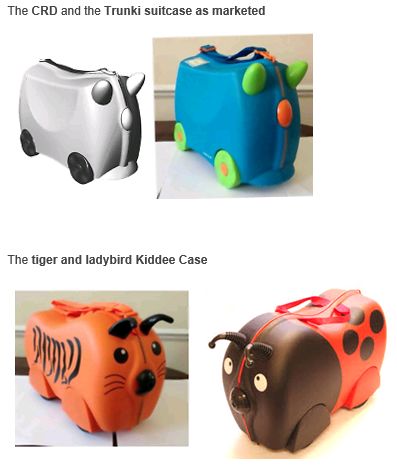Magmatic Ltd v PMS International Ltd [2014] EWCA Civ 181
Former Dragon's Den entrepreneur, Robert Law, designer of the well-known Trunki ride-on suitcase, suffered a major blow last week when the Court of Appeal reversed the previous High Court decision and found that the discount rival ride-on "Kiddee Case" did not infringe the Trunki's Community Registered Design.
Background
In May 2003, Magmatic Ltd ("Magmatic"), the company founded by Robert Law, applied for and was subsequently granted a Community Registered Design ("CRD") for the Trunki suitcase, which started selling in 2004. The CRD consisted of six monochrome representations of the exterior of the case from different angles and perspectives. The various handles and clasps of the Trunki gave the suitcase the appearance of a horned animal. In late 2012, PMS International Ltd ("PMS") began to import and sell similar ride-on suitcases at a discount price, under the trade mark "Kiddee Case". These cases were sold in two basic versions – an animal version with handles to look like ears and an insect version with handles to look like antennae. Each case had a graphic design on the surface to give the appearance of a tiger, leopard, cow, pig, ladybird or bee. It was common knowledge that the design of the Kiddee Case was inspired by the Trunki. In February 2013, Magmatic sued PMS for design infringement.

First instance decision
In the High Court decision in July 2013, Mr Justice Arnold held that the Trunki CRD had been infringed by the Kiddee Case. He said that on comparing the shapes of the Trunki and Kiddee Case, whilst there were some differences between the design features of both suitcases, the overall impression created by the designs on the informed user (the parent, carer or relative of a child) was the same. (Click here for a more detailed commentary on that decision). Mr Justice Arnold did, however, cast some doubt on whether his assessment had been correct so it is not surprising that an appeal ensued.
Court of Appeal decision
PMS appealed on the basis that Mr Justice Arnold had made mistakes in his first instance decision because he had wrongly interpreted the CRD and when comparing the suitcases, he had based his assessment only on the shape of the Kiddee Case but had ignored all other aspects of the design, including graphical surface designs. Mr Justice Arnold's view was that because the CRD for the Trunki was for the shape and did not show any graphical designs on the surface, the designs on the surface of the Kiddee Case had to be ignored. The Court of Appeal, however, took a different view.
The Court of Appeal said that Mr Justice Arnold had erred in two respects:
- He had failed to carry out a global comparison taking into account the nature of the CRD and the fact that the suitcase, when considered as a whole, looked like a horned animal, with a nose and a tail – one of the essential features of the design. It was necessary to consider the visual impression that the CRD and the Kiddee Case designs created, including any features appearing on the front and sides. The impression the insect Kiddee Case created was influenced by the two-tone colouring of the body, the spots and the handles on the forehead which looked like antennae. As a result, it resembled a ladybird. Likewise for the animal version, the stripes and whiskers and the handles which looked like ears gave the impression that it was a tiger. Neither of these was a horned animal and therefore they gave a very different impression from the Trunki CRD.
- Even though he had correctly found that the Trunki design, registered in monochrome, was not limited to particular colours, he had failed to take into account the distinct colour contrast between the wheels and body of the CRD. This was a striking feature of the CRD and was not present in the Kiddee Case.
In the circumstances, the Court of Appeal was free to re-evaluate whether infringement had occurred. It concluded that it hadn't. There were many significant differences between the cases - the profile of the Kiddee Case was asymmetric and more rounded than the CRD, the sides of the Kiddee Case did not have a ridge whereas the CRD did, the wheels of the Kiddee Case were covered by wheel arches whereas in the CRD they were not. Further, the judge said that the overall impression created by the two designs was very different - the impression created by the CRD was that of a horned animal - a sleek, stylised design with a symmetrical appearance with a significant cut away semicircle below the ridge. By contrast the design of the Kiddee Case was softer and more rounded and evocative of an insect with antennae or an animal with floppy ears. At both a general and a detailed level, the Kiddee Case conveyed a very different impression.
Comment
This is an interesting decision on the scope of Community registered design protection and the relevant factors to take into account when determining how similar or different competing products are, particularly with respect to surface decoration and colour contrast. It may also make design registrants think twice about the way in which they represent their designs in the actual design registration, in order to maximize on protection. Press reports indicate that Magmatic will appeal to the Supreme Court and take it to an even higher level in Europe if necessary. This is unsurprising given that the Trunki and Kiddee Case are clearly very similar visually (and indeed the Managing Director of PMS admitted that he developed the Kiddee Case off the back of seeing a Trunki on his travels) but at the same time, they have been found to create a different overall impression. Such a decision could have implications for other businesses trying to protect unique designs against copycat products and while it is important not to stifle competition, it is also important not to discourage creativity and entrepreneurial spirit. It is highly likely that there will be another instalment in this battle of the suitcases......
Article written by Rebecca Pakenham-Walsh, senior associate (PSL) in the IP Enforcement and Litigation group of Field Fisher Waterhouse LLP in London.
The content of this article is intended to provide a general guide to the subject matter. Specialist advice should be sought about your specific circumstances.

